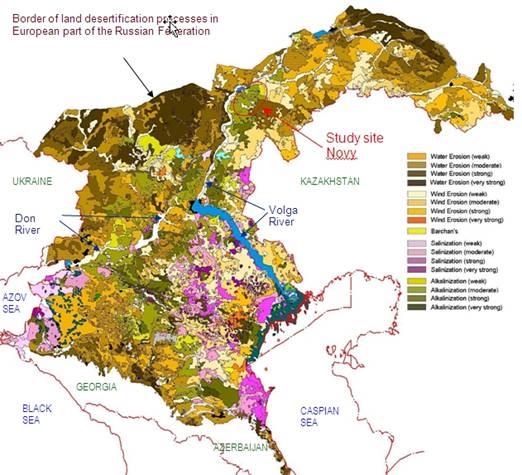Causes of desertification
The territory of the Marksovsky district as shown at Fig. 3 is located in a zone prone to land degradation and which according to the FAO classification is a zone of very high land degradation. After Kust (2002, research of land degradation indicators and processes mapping in South region of Russia (Fig. 3)) the main degradation process in this zone is soil alkalinisation.
From a scientific point of view a major land degradation problem in this area is caused mainly by the long time irrigation system used since its construction in the 1960s which provoked a ground water table rise due to over application of water. As a consequences the rising ground water provokes (1) water logging of irrigated and surrounding areas causing a change of soil water regime from semi-arid to semi-humid, (2) a secondary soil salinization due to dissolution of salt crystals held in the ground layers of the vadose zone and raising them to the upper root zone, which creates toxic conditions for plants and augments a soil water osmotic pressure leading to diminishing of interval of available for plants water in soil, (3) decreasing soil organic matter content due to leaching, which leads to soil compaction, damage of soil structure, worsening hydraulic conductivity & water retention capacity and other soil parameters.
From the land users' point of view a high groundwater level, a non-uniform pattern of soil fertility and extensive weed growth are consequences of former extended irrigation that is still maintained in some areas. Thus, the main degradation type of irrigated fields and surrounding territories is chemical soil deterioration, i.e. salinization: a net increase of the soluble salt content at the plant root zone leading to a productivity decline.

Fig. 3: Location of study area "Novy" within a map of land desertification processes in European part of Russian Federation (after Kust 2002)